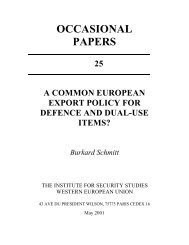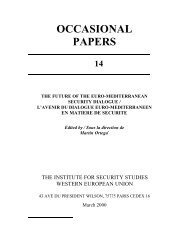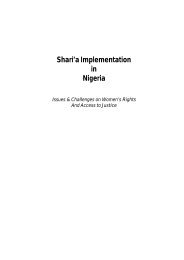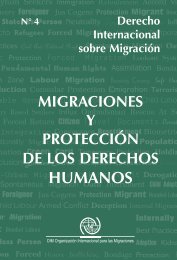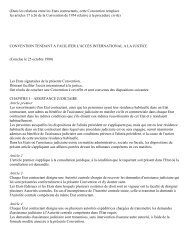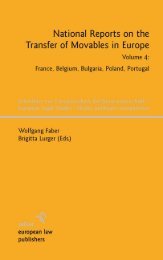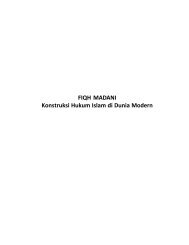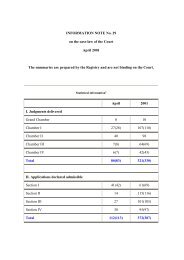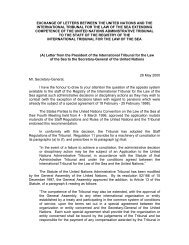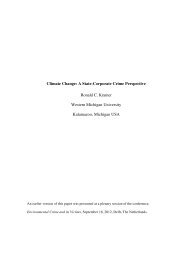Party Autonomy in International Property Law - Peace Palace Library
Party Autonomy in International Property Law - Peace Palace Library
Party Autonomy in International Property Law - Peace Palace Library
You also want an ePaper? Increase the reach of your titles
YUMPU automatically turns print PDFs into web optimized ePapers that Google loves.
5. <strong>Party</strong> <strong>Autonomy</strong> <strong>in</strong> <strong>International</strong> <strong>Property</strong> <strong>Law</strong>: A German Perspective<br />
emissions emanat<strong>in</strong>g from real property. The rule provides: ‘As to claims<br />
aris<strong>in</strong>g from the adverse effects of emissions from real property, the provisions<br />
of Regulation (EC) No. 864 / 2007 [Rome II] except for chapter III<br />
shall apply by way of analogy’. The doctr<strong>in</strong>al background beh<strong>in</strong>d this rule<br />
is that, under German substantive law, <strong>in</strong>junctive and similar protective<br />
claims under neighbour law are divided <strong>in</strong>to tort-related damages claims<br />
and property-related claims for rev<strong>in</strong>dication. 28 In the conflict of laws,<br />
however, splitt<strong>in</strong>g up a neighbour’s remedies between the lex situs and<br />
the lex loci delicti would lead to practical complications and possibly even<br />
to conflict<strong>in</strong>g judgments, deny<strong>in</strong>g under tort law what is allowed under<br />
property law, and vice versa. In contrast, a harmonised connection of tort<br />
law claims and rights <strong>in</strong> rem is justified by the fact that, at the level of<br />
substantive law, tort-related and property-related rules are elements of<br />
a f<strong>in</strong>ely balanced, closely <strong>in</strong>terwoven regulatory structure for delimit<strong>in</strong>g<br />
the respective scope of freedom and action of the polluter and the <strong>in</strong>jured<br />
party, which must not be divided by a two-pronged approach. This<br />
was already recognised by the German legislature <strong>in</strong> 1999. The orig<strong>in</strong>al<br />
version of Article 44 EGBGB, however, merely referred to the objective<br />
conflicts rule for complex torts (Article 40(1) EGBGB) and excluded<br />
party autonomy (Article 42 EGBGB). After the autonomous conflicts<br />
rules for torts were superseded by the Rome II Regulation, <strong>in</strong> particular<br />
Article 7 Rome II, which relates to environmental damage, 29 the provision<br />
was adapted to the Regulation. In this respect, it must be noted that<br />
the reference to Rome II <strong>in</strong>troduced <strong>in</strong> 2008 is not restricted to Article 7<br />
of the Rome II Regulation, but <strong>in</strong>cludes Article 14 Rome II as well, thus<br />
allow<strong>in</strong>g for party autonomy even <strong>in</strong>sofar as the pert<strong>in</strong>ent claims are characterised<br />
as belong<strong>in</strong>g to property law. The practical importance of this<br />
shift is slightly dim<strong>in</strong>ished by the fact that under an autonomous characterisation<br />
of nuisance claims <strong>in</strong> <strong>in</strong>ternational law, such claims are arguably<br />
with<strong>in</strong> Rome II’s scope of application anyway. The Court of Justice of the<br />
EU has decided with regard to the Brussels I Regulation that such claims<br />
must be characterised as delictual with<strong>in</strong> the mean<strong>in</strong>g of Article 5(3)<br />
28<br />
For closer analysis, see von He<strong>in</strong> / Wolf, Transboundary Environmental Damage<br />
<strong>in</strong> the Conflict of <strong>Law</strong>s, <strong>in</strong>: Wolfrum / Langenfeld / M<strong>in</strong>nerop (eds.), Environmental<br />
Liability <strong>in</strong> <strong>International</strong> <strong>Law</strong>: Towards a Coherent Conception<br />
(2005) 381 (424 et seq.).<br />
29<br />
For closer analysis of this provision, see Bogdan, The Treatment of Environmental<br />
Damage <strong>in</strong> Regulation Rome II, <strong>in</strong>: Ahern / B<strong>in</strong>chy (eds.), The Rome<br />
II Regulation on the <strong>Law</strong> Applicable to Non-Contractual Obligations (2009)<br />
219.<br />
Jan von He<strong>in</strong><br />
111<br />
© sellier. european law publishers<br />
www.sellier.de



